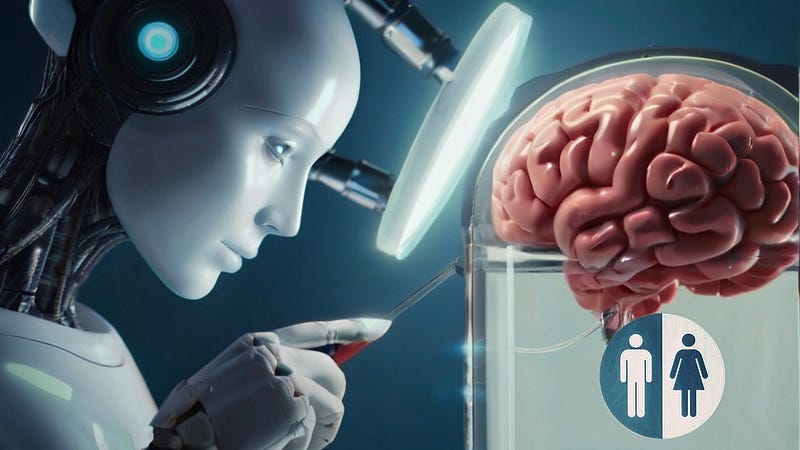Exploring Gender Differences in Brain Function and AI Insights
Written on
Chapter 1: The Intersection of AI and Neurology
Recent advancements in artificial intelligence (AI) are transforming our comprehension of the brain's complexities, leading to innovative approaches for treating neurological conditions. AI's analytical capabilities allow neurologists to delve deeply into the relationships between brain structure, functionality, and cognitive skills, thereby providing new perspectives on ailments like Alzheimer’s and Parkinson’s disease.
AI processes extensive datasets, including brain imaging, to discover subtle patterns and links previously undetectable. Early identification of neurological conditions can greatly enhance the quality of life for those impacted. Researchers are now better positioned to examine the brain's intricate framework, revealing subtle differences that might account for cognitive variations between genders.

Chapter 2: Decoding Gender Differences
AI plays a crucial role in illuminating the ongoing discussion regarding the fundamental distinctions between male and female brains. Recent advances in deep neural networks have unveiled unique functional configurations that differ between the sexes. Researchers can pinpoint specific brain networks that are essential in distinguishing male from female brains, offering insights into gender-specific vulnerabilities to neuropsychiatric disorders.
The video "Female brain vs. Male brain | Arina . | TEDxYouth@InternationalSchoolAndalucia" provides a fascinating overview of how gender differences manifest in brain function and structure.
Section 2.1: Understanding Brain Variations
The cognitive differences between male and female brains offer valuable insights into how gender influences brain function and behavior. While male brains are generally about 10% larger, this does not solely determine intelligence. Distinct observable differences exist in specific brain regions, such as the inferior-parietal lobule, which is linked to mathematical reasoning and spatial abilities.
Research indicates that men often show larger volumes or heightened activation in this region compared to women.
Section 2.2: Neuropsychiatric Insights
Neuroimaging has uncovered significant differences in brain activity across genders. AI-enhanced analysis of brain scans has pinpointed specific areas responsible for gender differences in brain organization. Understanding these structural and functional variations is crucial for advancing mental health research and developing targeted treatments.
The video "Are male and female brains different? - BBC REEL" explores the complexities of these distinctions and their implications for mental health.
Section 2.3: Chemical Composition and Neurotransmitter Differences
In addition to structural and functional differences, the chemical makeup of the brain also varies between genders, affecting how neurotransmitters are processed. Neurotransmitters, the chemical messengers facilitating neuron communication, are critical for various brain functions, including mood regulation, cognition, and behavior.
For instance, serotonin, which influences mood, sleep, and appetite, tends to be present in higher levels in men. This discrepancy may lead to differences in emotional processing and regulation. Conversely, dopamine levels, which affect reward processing and motivation, are also typically higher in men, potentially influencing risk-taking behaviors and cognitive functions.
Section 2.4: Hormonal Influences
Estrogen and testosterone—our primary sex hormones—significantly affect neurotransmitter functionality in the brain. Estrogen influences serotonin and dopamine levels, impacting cognition and mood, while testosterone modulates dopamine receptor activity, influencing behaviors like spatial reasoning and aggression.
Understanding these hormonal effects is vital for recognizing the different susceptibilities to neuropsychiatric disorders between genders. For example, serotonin dysregulation is often linked to mood disorders that are more common in women, while alterations in dopamine signaling are associated with conditions like schizophrenia and ADHD, which can exhibit distinct clinical features based on gender.
Chapter 3: Emotional Processing and Mental Health
Men and women exhibit different neural activity patterns in areas associated with emotional regulation and social cognition. Women typically show increased activity in the limbic system, correlating with heightened emotional sensitivity and empathy. In contrast, men may display reduced activity in the prefrontal cortex, affecting decision-making and impulse control.
These variations in emotional processing are crucial for mental health, as they may predispose women to mood disorders and men to externalizing disorders such as substance abuse.
Chapter 4: Precision Psychiatry and AI's Role
Customized diagnostic assessments and treatment strategies are essential for addressing the unique neurobiological profiles of male and female patients. Precision psychiatry employs advanced technologies to craft individualized treatment plans based on specific neurobiological and clinical characteristics.
AI-driven insights are invaluable in advancing our understanding of gender differences in brain function and cognitive abilities. By analyzing large neuroimaging datasets, AI helps researchers uncover patterns of brain connectivity and activity that reveal gender-specific variations in neuropsychiatric disorders.

The integration of AI with precision medicine holds great promise for unraveling the complexities of the mind, allowing for a more nuanced understanding of the interplay between genetics, environment, and brain function.